

Are you an IMG overwhelmed by the process of seeking residency in the United States? Do all the exams, documents, and requirements to certify your medical education seem like endless hoops you have to jump through? Do the ECFMG Pathways cause you confusion and anxiety?
If you are an IMG and have no idea what the ECFMG is or where to start your journey toward a US residency, check out our IMG Guide before reading this. On the other hand, if you know the ECFMG but need to make sense of the new Pathways system, you are in the right place.
Note: This article is current for the ECFMG Pathways for the 2023 Match.
Summary:
- An IMG needs to have graduated from a school with ECFMG eligibility on the World Directory of Medical Schools to apply for Certification.
- The ECFMG Pathways have replaced the USMLE Step 2 CS component.
- Occupational English Test Medicine is necessary for ECFMG Certification.
- Your status as a medical graduate or an international practicing physician determines which Pathway you follow.
- The ECFMG Pathways Application deadline is January 31st of the Match year.
Table of Contents
Useful Abbreviations
- ECFMG: Educational Commission for Foreign Medical Graduates
- GME: Graduate Medical Education
- IMG: International Medical Graduate (A graduate who attended medical school outside of the United States and Canada)
- LCME: Liaison Committee on Medical Education (accrediting authority for medical education in the US and Canada)
- MRA: Medical Regulatory Authority (in a given country)
- Mini-CEX: Mini-Clinical Evaluation Exercise
- NCFMEA: National Committee on Foreign Medical Education and Accreditation
- OSCE: Objective Structured Clinical Examination
- USMLE: United States Medical Licensing Exams
- WFME: World Federation for Medical Education
ECFMG: The Certification that Opens Doors
Doctors around the world have many different paths to and through medical school. Four years, six years, after completing undergrad or directly after high school, focus heavily on clinical skills and practical application or on research and intensive medical theory. The format of medical education varies by country.
This is where the Educational Commission for Foreign Medical Graduates comes in. They have developed a process to evaluate an IMG’s qualifications to ensure that healthcare professionals’ credentials are verified. So, if you want to do a residency or fellowship in the United States, you first need ECFMG certification.
World Directory of Medical Schools
The ECFMG certifies students from many, but not all, international medical schools. Want to check to see if you are eligible to apply for ECFMG certification? Find your school in the “World Directory of Medical Schools.” There, you can verify if your school’s graduates are eligible for ECFMG certification.
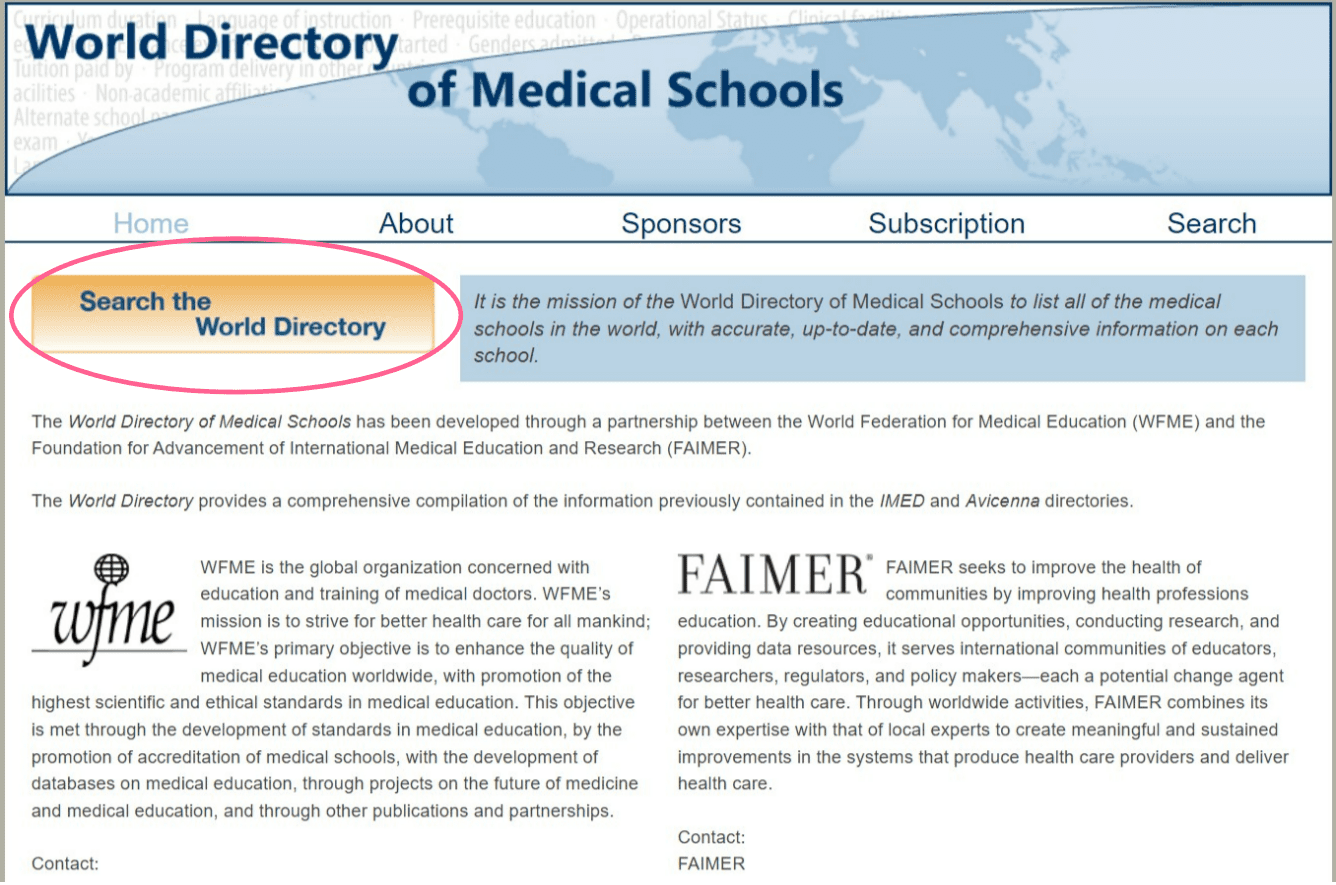
Search the directory to see if your medical school is eligible for ECFMG certification.
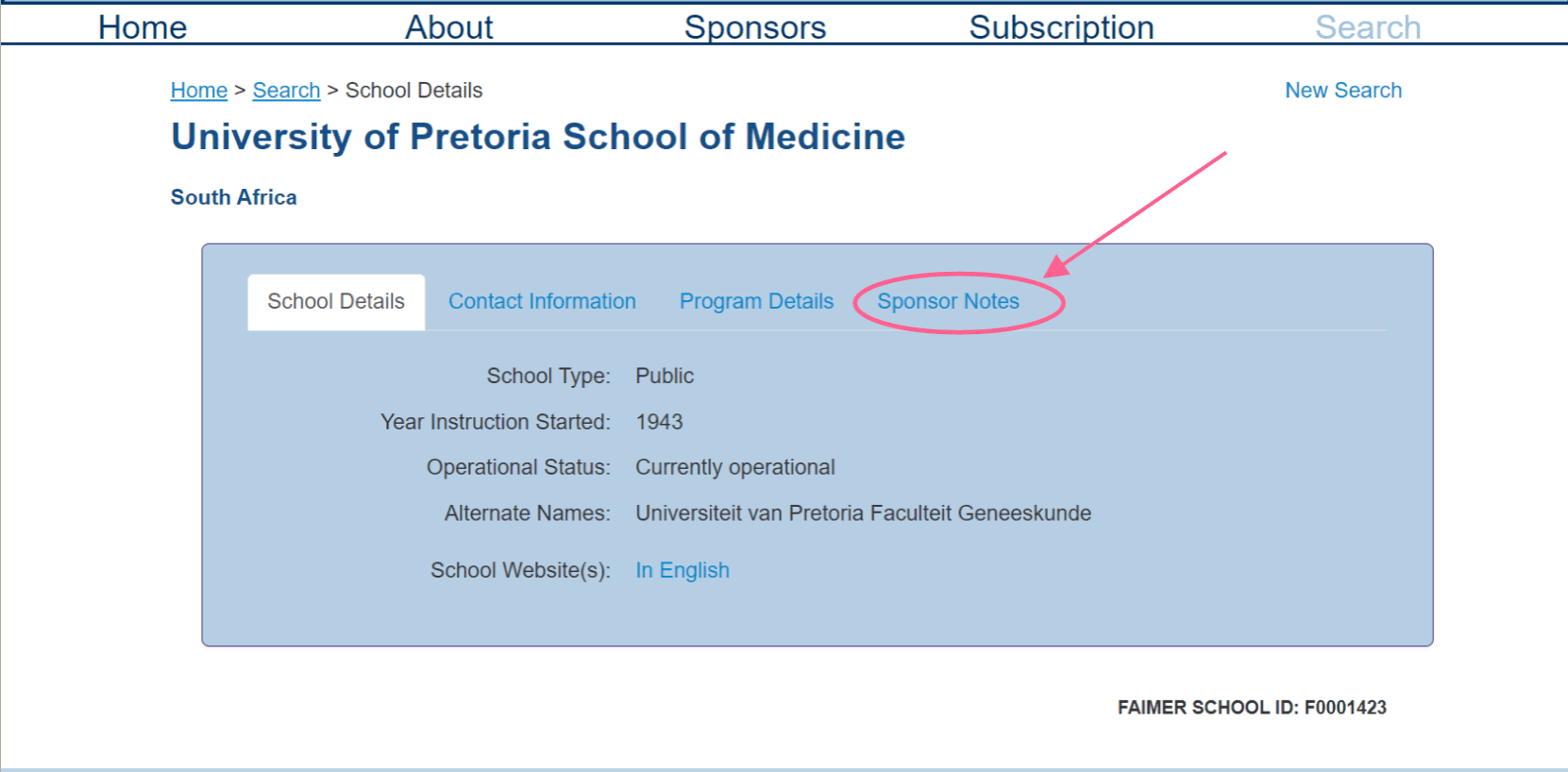
Select “Sponsor Notes” to determine which entities accept graduates from your medical school.
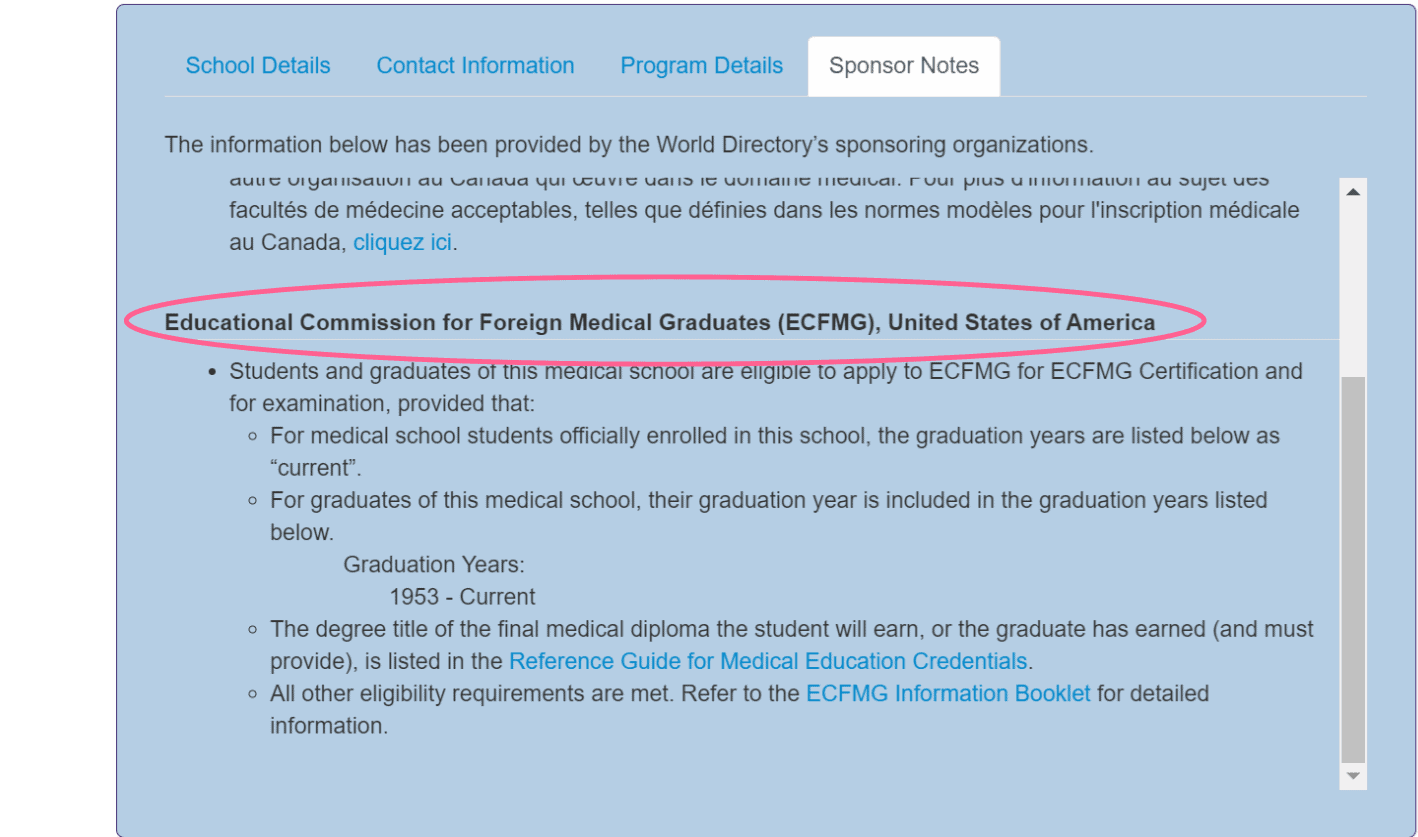
From here, you can see whether or not graduates are eligible to apply for ECFMG Certification and/or conditions that affect eligibility.
Note that in 2024, the ECFMG will require medical schools to be accredited. Per the ECFMG Information Booklet:
Important Note: Starting in 2024, individuals applying for ECFMG Certification must be a student or graduate of a medical school that is appropriately accredited. More specifically, the school must be accredited by an accrediting agency that is officially recognized by the World Federation for Medical Education (WFME). The WFME Recognition Programme is the only program accepted by ECFMG at the current time for the recognition of medical school accrediting agencies. Thus, beginning in 2024, medical schools will need to be accredited by a WFME-recognized accrediting agency if they wish to ensure their students and graduates are eligible for ECFMG Certification.
Certification Requirements
ECFMG Certification is not a quick process. They are part of why IMGs often feel like they are fighting an uphill battle. The IMG journey to residency in the US isn’t always straightforward, but with the ECFMG, it is possible. The steps are outlined below, but if you need further information, check out the ECFMG website.
- Apply for a USMLE/ECFMG ID.
- Submit an application for ECFMG certification. Note: this merely begins the process of ECFMG certification.
- Verify status as current student/graduate. The ECFMG must verify with your medical school that you are attending/have graduated. Verification is either electronic through the ECFMG Medical School Web Portal (EMSWP) Status Verification program or via a paper form (Certification Statement Form 183). Note: students report this can take anywhere from 1-4+ months. You should begin this process early, as you cannot take the USMLEs before verifying your student status.
- Graduate from med school. You must confirm your graduation from your medical school and receipt of your diploma with ECFMG.
- Apply to take the USMLEs. Once you have your ECFMG ID and have applied for ECFMG certification, you can sign up and apply for the USMLE exams.
- Pass all required USMLEs (Step 1, Step 2 CK). Check out average IMG Step 1 and Step 2 CK scores here to determine your target score for each specialty.
- Apply through the appropriate ECFMG Pathway (unless you have a passing score on the former Step 2 CS component).
What are the Pathways?
Step 1 and Step 2 CK test your science and clinical knowledge. But with Step 2 CS discontinued in 2020, there was a gap for a standardized clinical skills assessment.This is a big part of the ECFMG Certification process, so they devised the Pathways to fill this gap.
The Pathways certify you to enter supervised training in the US while assuring the public that you are competent and qualified. So, unless you passed Step 2 CS before it was discontinued, you have to apply to a Pathway to receive certification and participate in the Match.
What Do You Need to Apply to a Pathway?
So, precisely what is it you need to apply for a Pathway? Honestly, it depends on which you are eligible for. We will go through each Pathway in more detail, but first, there are a few general requirements.
- Completed an application for ECFMG Certification.
- Previous registration fCertificationep or Step Component.
- ECFMG has not barred you from pursuing certification.
- Passed the Occupational English Test for Medicine
ECFMG/USMLE Registration
If you are at the point of applying for an ECFMG Pathway, you have likely already registered for ECFMG certification or a USMLE. If you haven’t, do that first. It is straightforward with their online portal. Bookmark this portal, as it is also where you can complete the ECFMG application, register for USMLEs, and access your Certification Statement.
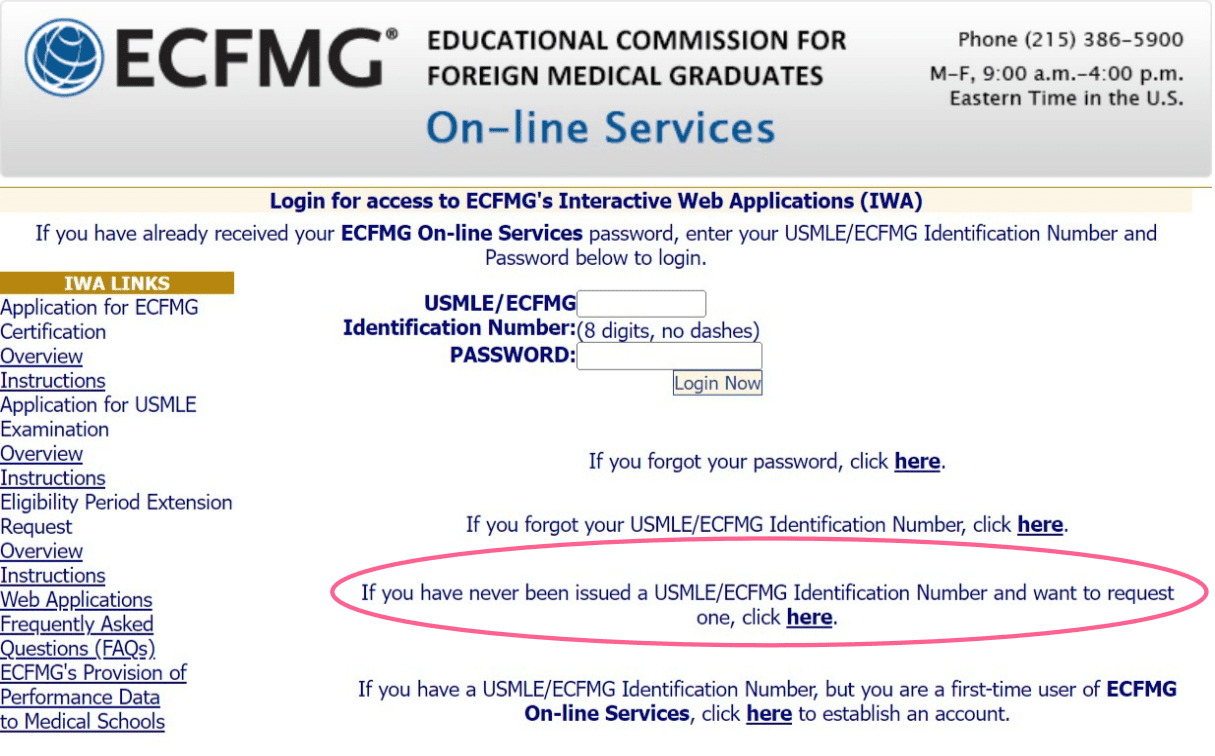
Creating a USMLE/ECFMG account is as simple as following the online instructions.
ECFMG clearly sets out directions for you to follow. It seems dense, but some important instructions and warnings are listed there. Some of it may seem like common sense (spelling your name correctly, using the information on your passport, using proper capitalization, etc.). However, carefully reading all the instructions could avoid future headaches. So take a few extra minutes and save yourself time in the long run.
OET Medicine
The OET Medicine is an English language proficiency and competency test designed explicitly for physicians. It has four components: listening, reading, writing, and speaking. You should study and prepare for this test even if you are a native English speaker. It is particular to the medical community, so having a prior understanding of the format and assessment expectations will give you the best chance of success.
For ECFMG, you can take the test as many times as it takes you to pass. Your goal is to score 350 or better on each listening, reading, and speaking sub-test. For the writing sub-test, you only need a score of 300. Once you have achieved this, you will need to release your scores from OET to ECFMG.
OET Medicine has step-by-step instructions on how to do that here. To ensure ECFMG receives your results in time for the Match, you need to make sure they are released before January 31st of the Match year.
Which Pathway is for You?
Now that we’ve established why the Pathways exist and the general requirements, let’s dive into the Pathways themselves. As mentioned above, there are six different Pathway options. Your eligibility depends on your current status as a practitioner or medical graduate in your home country.
Check out this decision tree to see which Pathway you are most likely eligible for:
This is a simplified version of the requirements, so you shouldn’t take it as a guarantee that you can apply for a particular Pathway. However, it should save you time in knowing where to start. It is worth noting that anyone who previously failed the former Step 2 CS should proceed directly to Pathway 6.
Pathway 1: For IMGs Licensed to Practice In Their Home Country
If you are already a licensed, practicing physician in a country outside of the US, this is your Pathway. The key to being eligible here is unsupervised practice. Your medical license does not even have to be currently valid, and an unsupervised provisional license is also acceptable. So long as you have never had disciplinary action taken against you, and your license was valid sometime after January 1, 2018, you are good to go.
As a doctor in another country, your practice experience already meets all of the clinical skills requirements for ECFMG. The only thing you need to prove is your current professional status. To prove this, you will need to obtain a Certificate/Letter of Good Standing or a document of Current Professional Status from the medical licensing authority in your country.
There are three potential ways to do this:
- (The recommended option) Request the medical licensing authority to send a Letter of Good Standing or its equivalent directly to ECFMG at licensure@ecfmg.org.
- Obtain the Letter of Good Standing from the licensing authority yourself. Then, upload the documentation with your Pathways application. The ECFMG will need to source and verify your paperwork, so understand that this could delay your application.
- As a last resort, if your medical licensing authority won’t issue a Letter of Good Standing, you can upload a copy of your medical license/registration with your Pathways application. ECFMG will attempt to do the verification for you, but this will likely significantly delay your application. So start the process early to allow plenty of time before the January deadline.
Pathways 2-5: IMGs Who Graduate from an Eligible, Accredited Medical School
Let’s say you aren’t licensed to practice yet, but you are well on your way there. After Pathway 1 is ruled out, the Pathways application system will use your ECFMG record to determine your eligibility for Pathways 2-5.
You are likely eligible for Pathways 2-5 if you are a graduate of a school that is:
- not in a region served by a WFME/NCFMEA accrediting agency but still accredited by the Medical Regulatory Authority of your country,
- accredited by WFME
- accredited by an agency that is deemed comparable to the NCFMEA,
- or partnered with a US medical school accredited by the LCME.
Note: For Pathways 2-5, you will need to have graduated on or after January 1, 2021.
If this seems a bit confusing, the easiest way to determine eligibility is to check the ECFMG’s list of pathway-eligible medical schools.
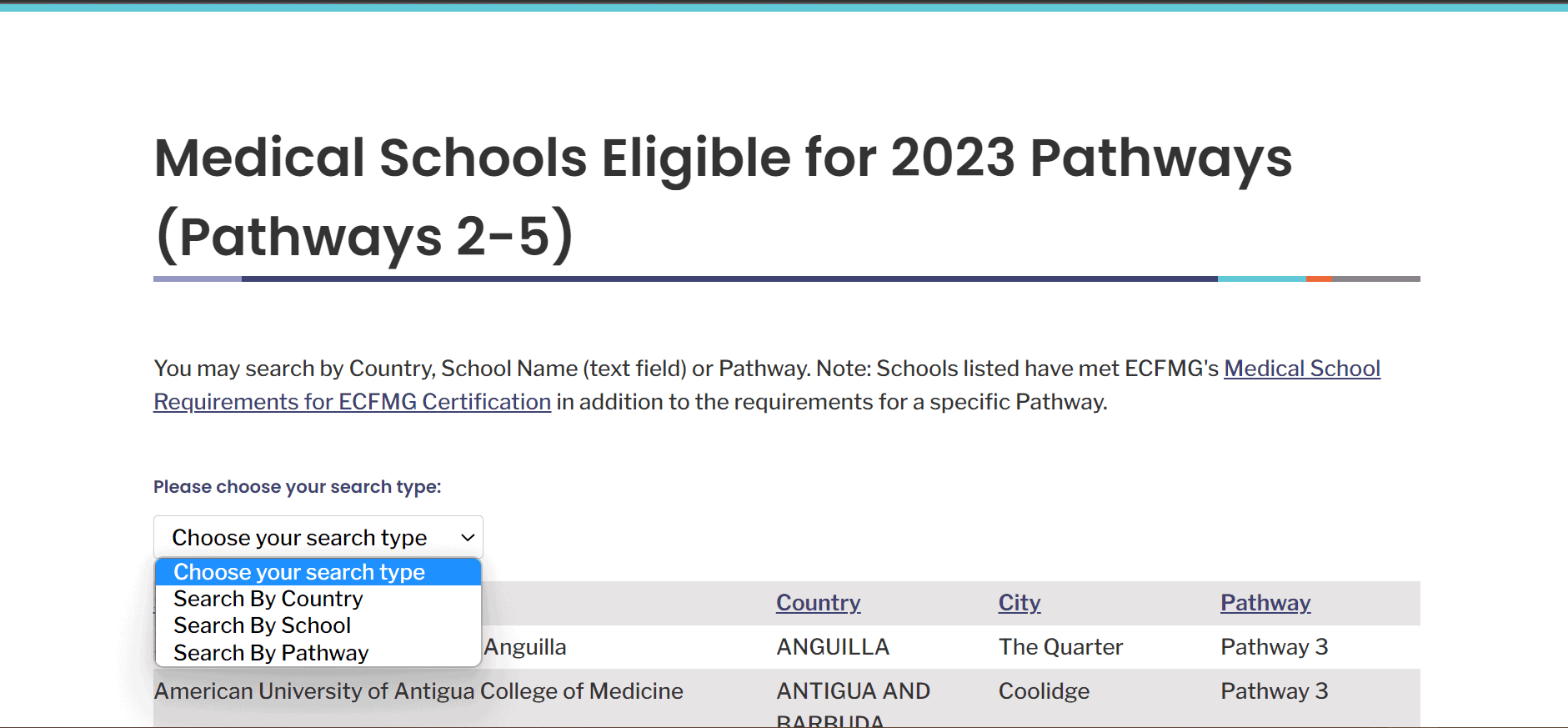
Sort the list by country, school, or Pathway to determine if you are eligible for Pathways 2-5.
There, you can sort the list by Pathway, country, or even medical school. This should give you an idea of which Pathway is your best option.
Pathway 2: For IMGs Who Passed an OSCE for Licensure
If your medical school facilitates OSCEs required by your country’s medical regulatory authorities, you might be eligible for Pathway 2. Even though you aren’t licensed to practice without supervision, you have undergone (and passed) a standardized clinical exam. Therefore, if your medical school is on the ECFMG list, they will consider your OSCE sufficient evidence of your clinical ability.
For Pathway 2, you need a copy of your final medical diploma/degree. ECFMG will source-verify this (if they haven’t already); that is all the extra documentation you need. If you haven’t received your final diploma yet, your medical school will need to send an OSCE Attestation form to ECFMG on your behalf.
You will need to download the OSCE Attestation after you have submitted the rest of your application. Reach out to an authorized medical school official and have them complete the form. You must ensure they send this form directly to ECFMG before January 31st of the Match year.
Pathways 3-5: For IMGs Who Are Accredited/Affiliated Through WFME, NCFMEA, or LCME
Pathways 3-5 are relatively similar in their requirements for eligibility and documentation. The only thing that changes is the accrediting agency. So, save yourself time and energy and use the sorting tool mentioned above. But, if you are ambitious, each Pathway’s accreditation agencies are listed below.
Pathway 3: WFME
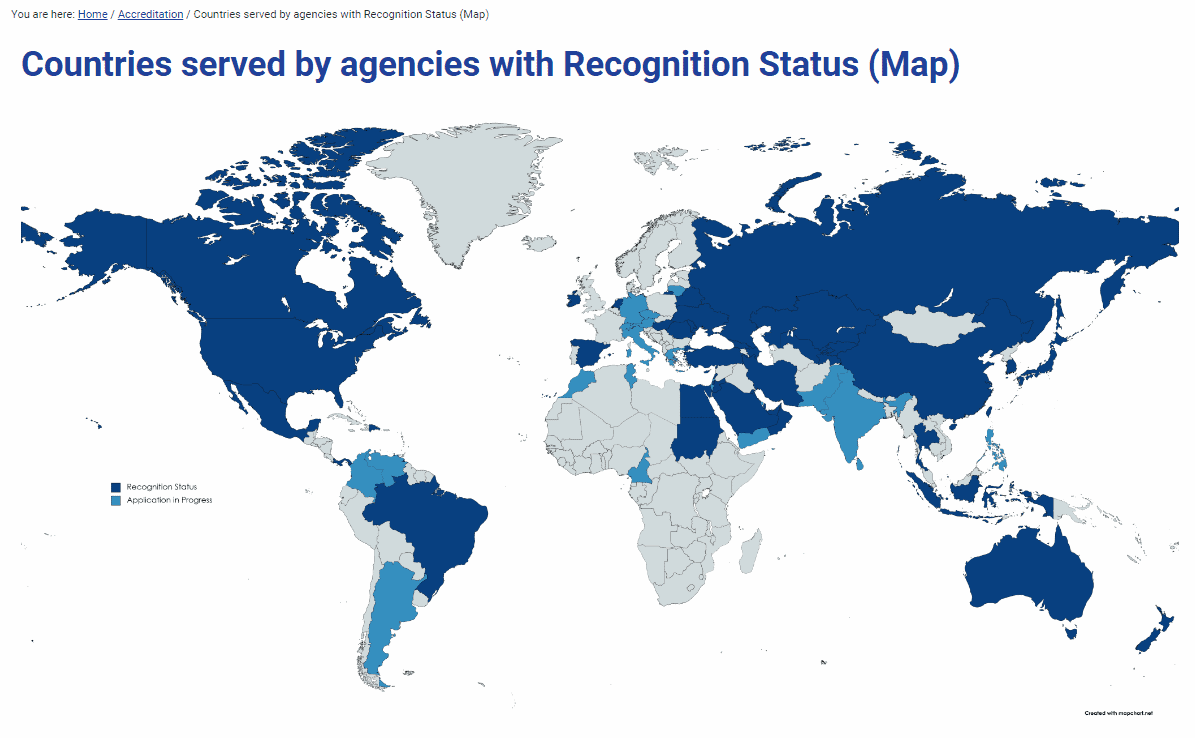
Countries with accrediting agencies recognized by WFME (as of October 2022)
Pathway 4: NCFMEA
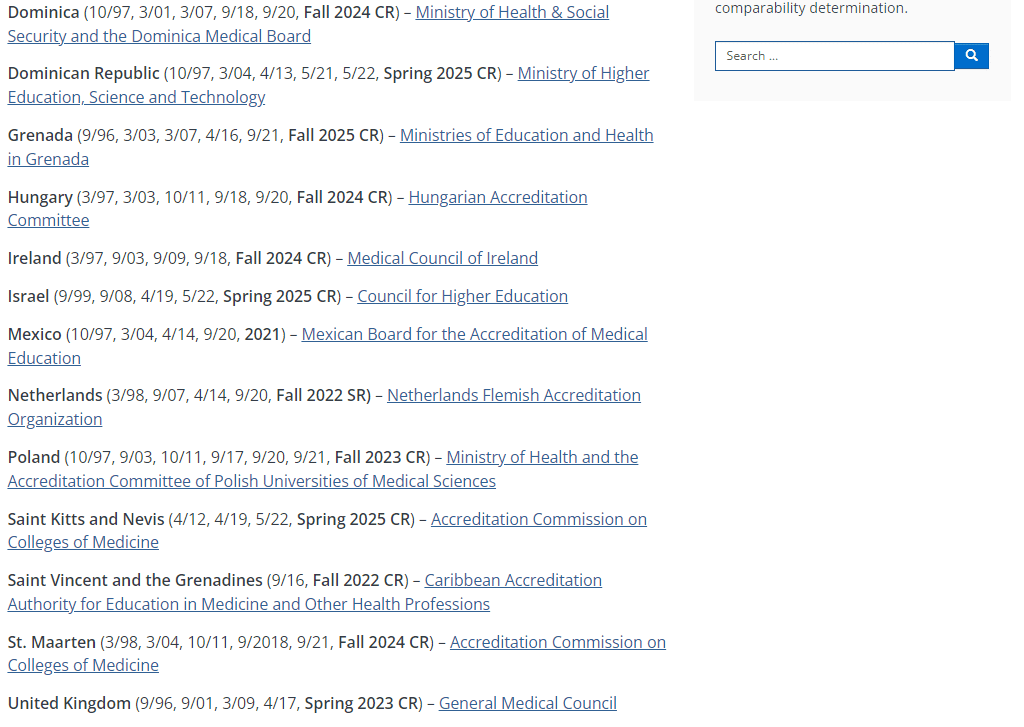
The NCFMEA has determined these countries have comparable accreditation standards to the US.
Pathway 5: LCME
Currently, there seem to be only two schools eligible for this Pathway: Duke-NUS Medical School of Singapore and Weill Cornell Medical College in Doha, Qatar. Suppose your medical school affiliates with a US medical school listed on the LCME link above (and meets the other eligibility requirements). However, it isn’t one of the two listed for Pathway 5. In that case, the ECFMG encourages you to reach out before starting a Pathways application.
Documentation for Pathways 3-5
As Pathways 3-5 are for applicants with similar levels of clinical experience, they require the same documentation. The ECFMG will need your medical school to complete a Clinical Skills Attestation Form. There are two ways to achieve this, depending on if your school uses the ECFMG Medical School Web Portal (EMSWP).
- If they use the EMSWP, your Clinical Skills Attestation request will automatically be sent directly to your school once you submit your application. Please don’t assume they will automatically see and fill it out, though. People are forgetful, and it is ultimately up to you to remind them and ensure they complete the electronic form before February 15 of the Match year.
- If your school does not use EMSWP, you must download the Clinical Skills Attestation form from your Application Summary screen when submitting your Pathways application. You will need to take this to an official of your medical school so they can fill it out and send it directly to ECFMG. If you take this route, you must ensure that ECFMG receives it before January 31st of the Match year.
Pathway 6: For Everyone Else
If you have gotten to this point and are not eligible for any other Pathways, you are probably wondering where you fit. Then, Pathway 6 is for you.
Because you don’t have the weight of an accrediting agency or standardized test backing you, you will need to have your clinical skills evaluated. They do this by having licensed physicians in your country evaluate you in six real, in-person clinical encounters. IMG, meet the ECFMG Mini-CEX.
Mini-CEX
The Mini-CEX is very similar to an OSCE in a natural clinical setting. The first thing you will need to do for Pathway 6 is to fill out the application. Your clinical encounters and evaluations must occur after submitting your initial application. Here is a logical timeline for the Mini-CEX:
- Fill out the Pathway 6 application.
- Ask 3-6 physicians to evaluate you for your Mini-CEX (maximum of 2 evaluations/doctor)
- Send them your evaluation request through the online application system.
- Complete 6 Mini-CEX patient encounters.
- Thank your physician evaluators and remind them to submit the evaluations to the online application system.
You can ask pretty much any licensed practitioner to evaluate you. As long as they agree to do the evaluation (and share their information with ECFMG), aren’t compensated outside of their usual employment, and have no relation to you, they qualify.
Acceptable Clinical Encounters
Before you panic and start thinking this will be an incredibly challenging evaluation, take a breath. They aren’t expecting you to diagnose rare diseases or run a code. This evaluation exercise is just to ensure that your clinical skills are acceptable for graduate medical education.
For this reason, your evaluation will need to be in a general or primary care setting. Peds, Family Med, General IM, and OBGYN would all be acceptable, according to ECFMG. Just remember to get permission from your patient before using their exam as your evaluation exercise.
To document these encounters, each physician evaluator must log in to ECFMG’s Clinical Skills Evaluation and Attestation Portal. There, they will find the necessary forms to score your Mini-CEX. In evaluating you, they will consider four categories:
- Medical Interviewing Skills: Can you collect a patient history? Can you effectively use questions to obtain necessary information? Is the patient history organized and accurate?
- Physical Examination Skills: Do you follow a logical sequence? Does your exam align with the patient’s problem/presentation? Are you sensitive to the patient’s needs?
- Professionalism/Communication Skills: Can you establish trust and communicate with compassion? Do you respond to non-verbal cues from the patient?
- Clinical Reasoning and Judgment: Can you deliver a presentation of the patient’s problems with a differential diagnosis and recommendations for next steps?
They will score your evaluation on a performance scale of 1-9. With one indicating you perform like a new med student with minimal clinical or practical experience and nine indicating you perform like an experienced, practicing doctor.
Once the ECFMG has received all six of your evaluations and any other outstanding documentation, they will review your Pathway application.
Other Useful Information
Now that you know which Pathway to apply for, you can start contacting the necessary authorities, gathering your documents, and planning your application timeline. Then, use the online portal to complete and submit your Pathways application.
When Should You Apply for a Pathway?
Let’s talk about when you should apply for a Pathway. For ECFMG Certification, you have seven years to complete the process from the time you pass the first USMLE exam. This means that if you passed Step 1 on January 10, 2018, you have until January 10, 2025, to complete Step 2, your OET Medicine, and your Pathways application before your Step 1 score becomes invalid.
People work on different timelines, so the amount of time it takes to get through all the exams and requirements will vary. However, you should apply for your Pathway only after you have passed your USMLE exams. This will ensure you won’t have to redo your clinical skills requirements if you encounter a hiccup with Step 1 or Step 2.
The deadline for a Pathway Application is January 31st of the Match year. This means all required documentation and paperwork must be submitted to ECFMG before that date. Suppose you attended medical school in a country where bureaucratic and regulatory bodies are less organized and more like organized chaos. In that case, you should start the process well before the January deadline. You can even start requesting documentation BEFORE you begin your Pathway application. Just be aware that some items must be submitted to ECFMG within 90 days of the document’s issue date. Once you start the Pathway application, you will have five days to complete and submit it.
Average Cost of Certification
Seeing the cost of ECFMG certification can be a shock at first and feel like an obstacle to obtaining your goal of a US residency or career. For many, this is a worthwhile investment into their future. You can prepare and avoid surprise fees by breaking down some major expenses. Here the some of the highest unavoidable costs:
| Examination/Service | Cost in $ |
|---|---|
| Application for ECFMG Certification | $160 |
| USMLE Step 1 | $985 |
| USMLE Step 2 CK | $985 |
| OET Medicine | $455 |
| Pathways Application | $925 |
| CVS (Certification Verification Service) | $66 |
| J-1 Visa Application | $370 |
| Total | $3946 |
See the ECFMG website for a more comprehensive breakdown of possible fees, including translation costs, score rechecks, eligibility extensions, etc.
Expiration of the ECFMG Certificate
You’ve gone through the lengthy process to get your ECFMG Certification, but now you need to know how long you have before it expires. The good news is that if you enter an ACGME-accredited program in the US and complete your first year of training, you are good! You’re ECFMG Certificate will no longer expire. It becomes permanently valid, and you will never have to go through the ECFMG Certification process again.
If you don’t enter an accredited training program immediately, your ECFMG Certificate will expire onCertification the year after the Match. For example, if you received your certification for the 2023 Match, your certificate would expire on December 31, 2024. You would then be required to re-meet whatever clinical and communication skill requirements are valid at that time.
Concluding Thoughts
It is ultimately about a process of elimination. If you aren’t eligible for Pathway 1, explore Pathway 2. If your medical school isn’t eligible for Pathway 2, it might be eligible for 3, 4, or 5. When none of those are suitable for you, then Pathway 6 is your only option.
Deciding to train or work in the US will have a long-term impact on your life. This goal of this article is to simplify the ECFMG Pathways and make the road to Certification a little clearer.
How much did this guide help clarify the ECFMG Pathways? Let us know in the comments!

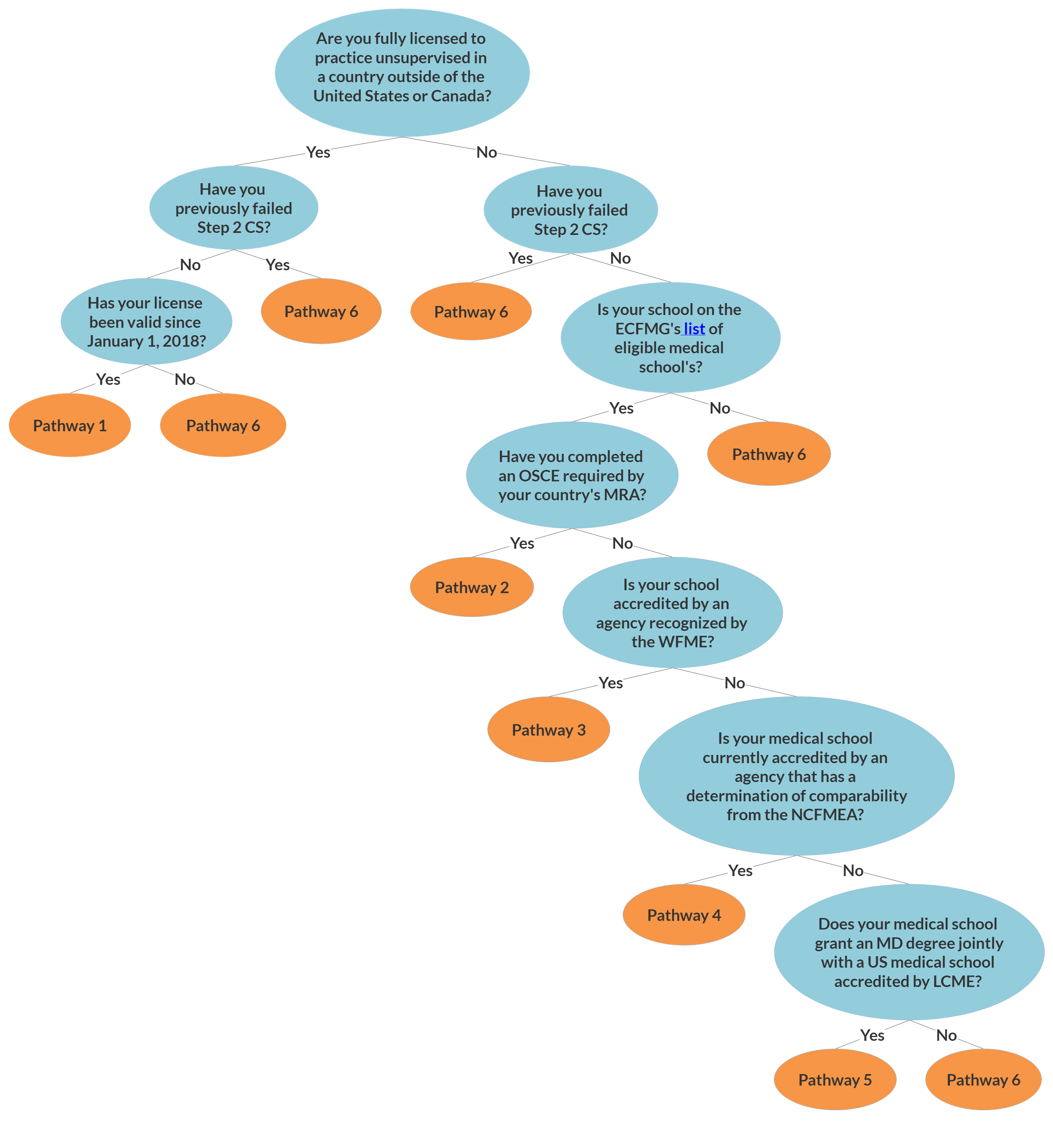
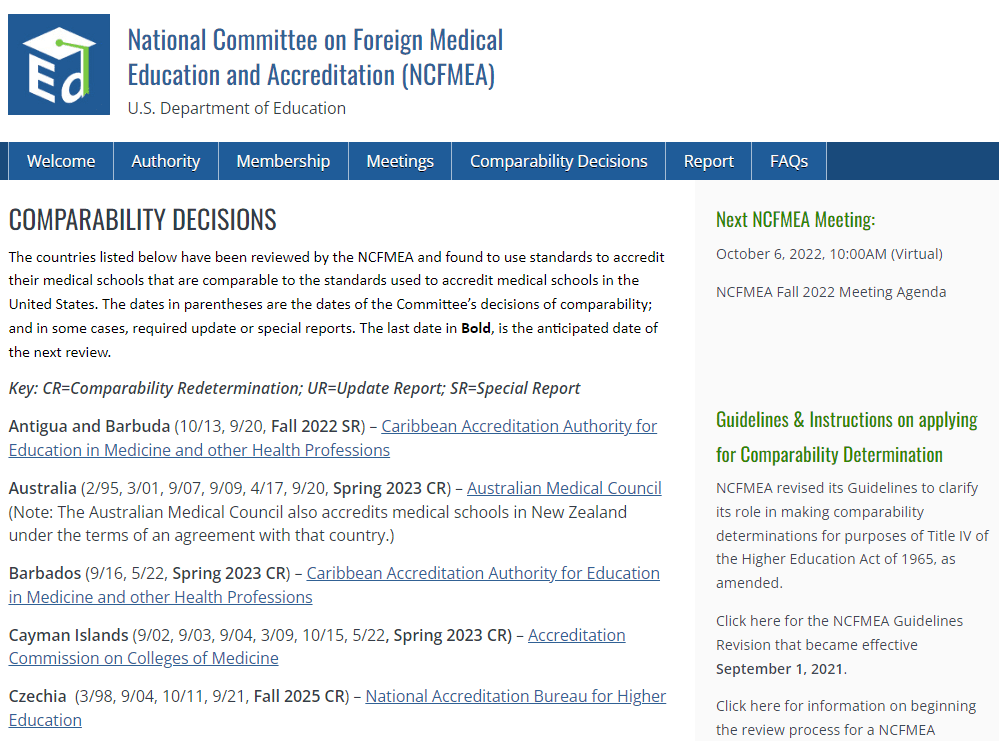







Hi,
Thank you for this useful article!
Do I have to have graduated with my medical diploma before applying to a pathway? Or can I apply during my final year of medical school?